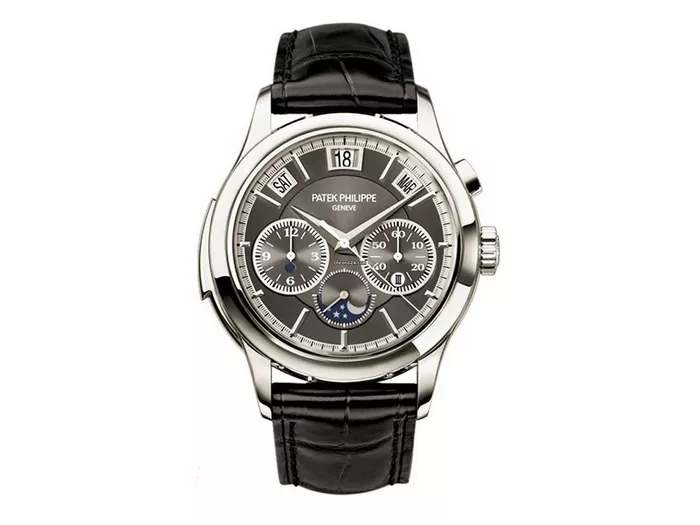Patek Philippe, a name synonymous with luxury and precision, has once again captivated the horological world with the 5208P Perpetual Calendar. This timepiece stands as a testament to Patek Philippe’s commitment to pushing the boundaries of watchmaking. In this ultimate review, we delve into the intricacies of design, complications, movement, and the overall experience offered by the Patek Philippe 5208P Perpetual Calendar.
1. Design Excellence: Platinum Elegance
The 5208P boasts a 42mm platinum case, reflecting Patek Philippe’s dedication to using the finest materials. The platinum not only enhances the watch’s aesthetic appeal but also ensures durability and resistance to tarnish. The blue sunburst dial, adorned with baguette-cut diamond hour markers, adds a touch of opulence. The overall design strikes a harmonious balance between sophistication and functionality, making the 5208P a true masterpiece.
2. Complications Beyond Compare: Triple Complication Marvel
At the heart of the 5208P is a triple complication that includes a perpetual calendar, a minute repeater, and a monopusher chronograph. The perpetual calendar automatically adjusts for months with different lengths, including leap years. The minute repeater chimes the time on demand, while the monopusher chronograph allows precise measurement of elapsed time. The seamless integration of these complications showcases Patek Philippe’s technical prowess and dedication to horological innovation.
3. In-House Marvel: Caliber R CH 27 PS QI
Powering the 5208P is the in-house Caliber R CH 27 PS QI, a manual-winding movement that epitomizes precision and craftsmanship. This movement not only drives the perpetual calendar, minute repeater, and chronograph but also features a moon phase display. The exquisite finishing of the movement, including the Geneva stripes and beveled edges, reflects Patek Philippe’s commitment to excellence in every detail.
4. Perpetual Calendar Precision: A Complication Mastered
The perpetual calendar in the 5208P is a pinnacle of precision. It not only displays the day, date, and month but also accounts for leap years, ensuring accurate timekeeping for generations. The moon phase indicator adds a poetic touch to the dial, depicting the waxing and waning of the moon with remarkable precision. The perpetual calendar in the 5208P is a true testament to Patek Philippe’s mastery in creating intricate and reliable complications.
5. Melodic Symphony: The Minute Repeater
The minute repeater in the 5208P transforms timekeeping into an auditory experience. With the push of a lever, the watch chimes the hours, quarters, and minutes, creating a melodic symphony. The intricate mechanism behind the minute repeater is a testament to Patek Philippe’s dedication to preserving the artistry of traditional watchmaking while incorporating it into a contemporary masterpiece.
6. Monopusher Chronograph Brilliance
The monopusher chronograph in the 5208P allows precise measurement of short intervals with the simplicity of a single pusher. This chronograph function not only adds a layer of functionality but also showcases Patek Philippe’s commitment to engineering excellence. The smooth operation of the monopusher reflects the brand’s mastery in creating chronographs that are both user-friendly and highly accurate.
7. Limited Edition Rarity
As with many Patek Philippe timepieces, the 5208P is produced in limited quantities, adding an extra layer of exclusivity. Each watch is individually numbered, emphasizing its rarity and making it a sought-after collector’s item. The limited edition status further elevates the prestige associated with owning a Patek Philippe complication.
Frequently Asked Questions (FAQs)
Q1: What makes the perpetual calendar in the 5208P special?
The perpetual calendar in the 5208P is a highly advanced complication that not only displays the day, date, and month but also accounts for leap years, ensuring accuracy for an extended period. The moon phase indicator adds a poetic touch, showcasing the moon’s phases with remarkable precision.
Q2: How does the minute repeater function in the 5208P work?
The minute repeater in the 5208P chimes the hours, quarters, and minutes on demand. It is activated by a pusher, transforming timekeeping into a melodic symphony. The intricate mechanism behind the minute repeater reflects Patek Philippe’s dedication to preserving traditional watchmaking artistry.
Q3: Can you elaborate on the design and materials of the platinum case in the 5208P?
The 42mm platinum case in the 5208P reflects Patek Philippe’s commitment to using the finest materials. Platinum not only enhances the watch’s aesthetic appeal but also provides durability and resistance to tarnish. The blue sunburst dial and baguette-cut diamond hour markers add a touch of opulence.
Q4: What sets the monopusher chronograph in the 5208P apart?
The monopusher chronograph in the 5208P allows precise measurement of short intervals with the simplicity of a single pusher. This function not only adds functionality but also showcases Patek Philippe’s engineering excellence. The smooth operation of the monopusher reflects the brand’s mastery in creating user-friendly and accurate chronographs.
Q5: How often does the 5208P require manual winding?
The 5208P is a manual-winding watch, and it typically requires winding every 48 hours to maintain optimal power reserve. Regular winding ensures the accuracy and proper functioning of the watch.
Q6: Is the 5208P suitable for everyday wear, considering its complications?
While the 5208P is a remarkable piece of haute horlogerie, its complexity and precious nature may lead some owners to reserve it for special occasions. However, the robust construction and exquisite design make it suitable for those who appreciate complications in their daily watch.
Q7: How can one ensure the longevity of the Caliber R CH 27 PS QI movement in the 5208P?
To ensure the longevity and optimal performance of the Caliber R CH 27 PS QI movement, regular servicing by authorized Patek Philippe service centers is recommended. This includes cleaning, lubrication, and any necessary adjustments to maintain the movement’s precision and reliability.

